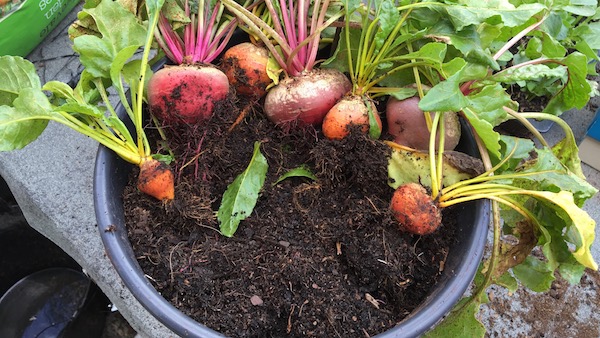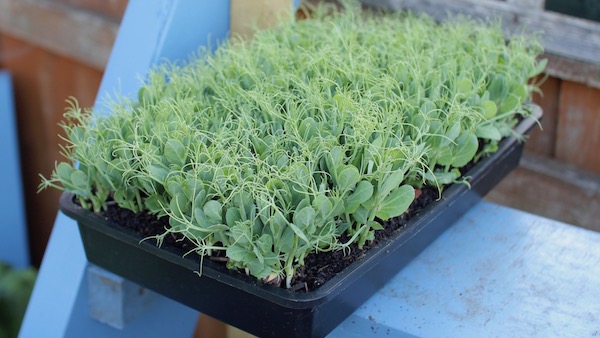What size container do I need?

What size containers are best to grow veg, fruit and herbs in? Here is the information you need to help you choose.
Is depth or volume more important?
The general rule is: the bigger the pot, the bigger the crop. The volume of the pot is more critical than the depth. 15cm (6 inches) is deep enough for most crops (although some root crops may need more), as long as the volume is large enough.
Pros and cons of big pots
There are several reasons why it is easier to grow successfully in larger pots:
- They dry out less quickly. This makes watering easier. It also reduces the stress on your plants. Most crops don't like rapidly fluctuating water levels - it slows their growth and often triggers premature bolting (this is when a plant goes to seed before you want it to - rocket and coriander do this a lot, for example).
- They hold more nutrients, ideal for hungry vegetable crops.
- They offer more space for the plants root systems - enabling the plant to grow bigger and stronger.
- They're better at sustaining beneficial soil life, like worms. This helps you to mimic natural soil growing conditions in your pots. This in turn makes for healthier and more disease resistant crops.
However, large post also have drawbacks
- Critically, they take up precious space - space that many homes don't have.
- They weigh more, requiring more physical work to fill and move. Weight is also an important issue to consider if you're growing on a balcony or rooftop.
- They cost more (in both pot and soil)
Pros and cons of small pots
Smaller pots, on the other hand, are not as easy to grow in but are a good choice for some situations because:
- They're cheaper to buy and fill
- They're lighter and easier to move around,
- They take up less space.

You can fit more small pots in a space - and they are easier to lift on to a shelf like this. Most leafy veg will grow fine in them.
The downsides of small pots are
- They dry out faster. This puts stress on the plant and creates more work for you watering. You can get round this problem by using a container with a water reservoir or setting up a self watering system.
- They need more regular feeding - observe plants carefully.
- You're more limited in what will grow in them. Don't try big hungry crops in them like courgettes.
What volume of pot do different crops need?
Nearly all edible plants grow better and bigger in larger pots. However some types of crops can be grown more successfully in smaller pots than others. Here are some general rules:
Fruiting crops
Most fruiting crops really do need a larger pot to fruit well. The larger the fruit they produce, the larger the pot they need. For example, squash do best in a container of 50 litres (10 gallons), while small chillies can be grown successfully in a 5 or 10 litre (1 to 2 gallon) pot, tomatoes in 10 to 20 litres (2 - 4 gallons).

Large fruiting crops like this squash need a big pot to grow well. This one is in a 50 litre (10 gallon) pot.
Leafy crops
Leafy crops can be grown successfully in large or small pots. The difference is that in large pots, they will grow larger and can usually be harvested over a longer period. In small pots, the leaves will be smaller. However, as long as the plant is kept well watered the small leaves will taste just as good.
Root crops
Root crops are similar to leafy crops. You'll get bigger roots in large pots than small pots.

Root crops like beetroot, carrots and potatoes, will grow ok in a 10 litre (2 gallon) bucket like this.
So which is best?
If space, budget and weight is no issue, then large pots (20 litres / 5 gallon or larger) are usually the best choice for most crops. But as urban growing IS usually constricted by space, weight or budget (and often all three) a mix of sizes is often a good solution. The best solution for you will depend on how much space you have and what you want to grow. This is what I usually do:
- I grow microgreens in seed trays or mushroom crates lined with newspaper.
- I grow salads and herbs in smaller pots - either window boxes or small plastic buckets (10 litre / 2 gallons).
- I grow larger leafy veg and roots in 10 or 20 litre (2 - 4 gallon) buckets or the large plastic supermarket veg trays that hold 50 litres (10 gallons).
- I grow chillies in 10 litre buckets, tomatoes in 20 litres, peas, beans and courgettes in 20 litres minimum (40 litres is better), and squash in 40 litres or bigger.

Pea shoots and microgreens grow well in containers as small as seed trays - so make a great choice for very small spaces.
Your turn?
What size pots do you use, and which size works best for you?

17 comments
Leave a comment